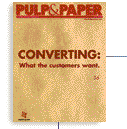|

CHRISTER IDHAMMAR
is president and CEO of IDCON Inc., Raleigh, N.C., a company specializing in training and implementation of improved operations, maintenance organizations,and practices.
I am interested in receiving feedback and results from you concerning this column. Please feel free to contact me by phone at:(919) 847-8764 fax: (919) 847-8647 e-mail: c_idhammar@idcon.com
Paper Industry Maintenance ’99 Conference & Exhibition, Oct. 11-15, Atlanta, Ga. PIM ’99 is an excellent opportunity to improve maintenance operations. You’ll learn valuable tips and practical pointers on cost-effective failure analysis, team building, and more. Call or fax for information and an updated program. phone: (817) 255-8021 fax: (817) 255-8070
|

Preventive Maintenance III
In the February and April issues of Pulp & Paper, I discussed methods for developing a good preventive maintenance (PM) program. In this column, I further comment on reasons why your PM program might not always work as well as you would like it to work.
DOCUMENTATION AND TRAINING. When you select the right PM procedure, you need to document this procedure. It is important that you decide on the format for this document, because it should be used to train people and to improve the chosen procedure in the future. Remember that, in this case, we are talking about basic inspection methods, not predictive maintenance methods such as vibration analysis, wear particle analysis, etc.
In our program, we have chosen to call these procedures condition monitoring standards (CMS). We use a lot of pictures to describe these procedures, since it is easier and safer to describe a method with a picture than with words. The document also stands a better chance of being read and understood if it includes pictures.
At a minimum you need to include what, how, and, especially, why an inspection should be done. It takes time to develop these documents, but remember that if you have done one, such as for a coupling, this document will be reused for all other couplings of this type. Frequencies and other values unique to the individual component will be described in the route list.
I also recommend that you do not use off-the-shelf documents. Developing documents is good training for teaching the future PM inspectors to document as many CMS procedures as possible, and it also promotes ownership of the system.
Do not make the mistake of believing that craftspeople or operators know how to inspect components. My experience is that craftspeople have been trained to do repairs and to troubleshoot existing problems. Very few have been trained to find problems in inspections before they actually become problems. Much of this training is a thought process; you need to teach people to think of inspections in terms of anticipating latent problems.
The CMS documents, together with professionally available training material, form very unique and effective training material for operators and craftspeople. At a minimum, the training should include inspection methods for the most common components and systems, as well as a review of useful basic instruments and tools such as high intensity lights, strobes, handheld IR instruments, mirrors, leak detectors, etc.
ASSIGN RESOURCES. It seldom works well to just say, “PM is priority one, and we will assign different people to do it as we see the need,” or, even worse, “our team members decide among themselves who will do the inspections today.” This almost guarantees that your PM effort will fail. Another common mistake is to assign people on the shifts to do PM when they have nothing else to do. If they have nothing else to do, they are not needed on the shift. The first thing that will be sacrificed in this scenario is the PM.
In my experience dealing with several hundred mills, the best results are achieved when special people are assigned to do inspections on a full time basis. If you assign dedicated resources to do basic inspections of equipment you will get:
- The right people to do the inspections, adjustments, and repairs. They can do them during their routes, or after they complete their routes.
- The right people trained in this unique work.
- The ownership and interest for PM that is necessary for continuously updating and improving the PM work.
- An easier situation to manage, since it is tempting for a supervisor to pull people chosen for PM in order to do unplanned work that has been added onto schedules at the last minute.
Wherever the assigned resources (PM inspectors) report in your organizational structure, I advise that they work closely with the supervisor in the area they inspect. Make sure the PM inspectors report their findings and what they have inspected to the supervisor once or twice a day. When their routes are completed, they should do some of the repairs and adjustments that are the results of the inspections. This cuts back on administration and eases up the friction that can develop with the craftspeople that otherwise have to do all repairs.
Another bit good advice is to start all routes with an interview of the operators in the area to be inspected; this will improve communication and on-the-job training of operators. More PM advice will appear in the August Pulp & Paper issue.

|





